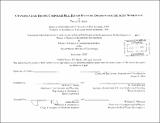| dc.contributor.advisor | W. Tod McGrath. | en_US |
| dc.contributor.author | Hardy, Trevor J. F. (Trevor John Fraser), 1977- | en_US |
| dc.contributor.other | Massachusetts Institute of Technology. Dept. of Urban Studies and Planning. | en_US |
| dc.date.accessioned | 2006-03-29T18:26:52Z | |
| dc.date.available | 2006-03-29T18:26:52Z | |
| dc.date.copyright | 2002 | en_US |
| dc.date.issued | 2002 | en_US |
| dc.identifier.uri | http://hdl.handle.net/1721.1/32239 | |
| dc.description | Thesis (S.M.)--Massachusetts Institute of Technology, Dept. of Architecture; and, (S.M.)--Massachusetts Institute of Technology, Dept. of Urban Studies and Planning, 2002. | en_US |
| dc.description | Includes bibliographical references (p. 138-142). | en_US |
| dc.description.abstract | Given the needs of corporations in the global business environment, corporate real estate investment decisions represent strategic choices that support a company's overall business strategy. This thesis clearly illustrates that, contrary to the Modigliani Miller theorem, companies do face real trade-offs in deciding how they finance their real estate investments. Notwithstanding the need to customize decisions on behalf of the business unit customers and to ensure that these choices are economically sound within a given region, there are significant factors that drive real estate decision makers to make a particular financing decision. By analyzing these factors in relation to the financing alternatives available a comprehensive framework of decision drivers is developed to aid eRE managers in gathering relevant information in order to evaluate the overall effectiveness and trade-offs associated ,with each alternative. Through a series of case studies it is then shown that financing decisions which optimize the real estate portfolio 1) clearly reflect the financial and operational requirements of both the company and business units; 2) are very much part of a larger portfolio wide corporate real estate strategy, which is closely allied to the company's overall corporate strategy; 3) take into account the perspectives of other role players (IT,HR, Finance) in the decision making process. | en_US |
| dc.description.statementofresponsibility | by Trevor J.F. Hardy. | en_US |
| dc.format.extent | 142 p. | en_US |
| dc.format.extent | 14729494 bytes | |
| dc.format.extent | 25573309 bytes | |
| dc.format.mimetype | application/pdf | |
| dc.format.mimetype | application/pdf | |
| dc.language.iso | eng | en_US |
| dc.publisher | Massachusetts Institute of Technology | en_US |
| dc.rights | M.I.T. theses are protected by copyright. They may be viewed from this source for any purpose, but reproduction or distribution in any format is prohibited without written permission. See provided URL for inquiries about permission. | en_US |
| dc.rights.uri | http://dspace.mit.edu/handle/1721.1/7582 | |
| dc.subject | Architecture. | en_US |
| dc.subject | Urban Studies and Planning. | en_US |
| dc.title | Changing gear : driving corporate real estate financing decisions for the agile workplace | en_US |
| dc.type | Thesis | en_US |
| dc.description.degree | S.M. | en_US |
| dc.contributor.department | Massachusetts Institute of Technology. Department of Architecture | |
| dc.contributor.department | Massachusetts Institute of Technology. Department of Urban Studies and Planning | |
| dc.identifier.oclc | 52044840 | en_US |
